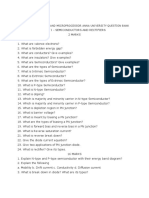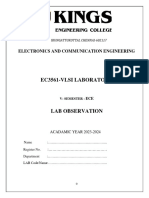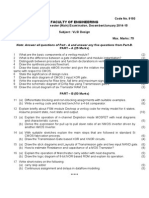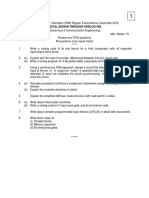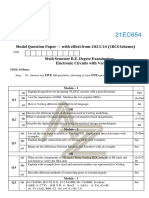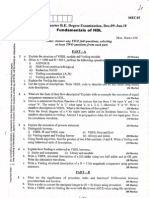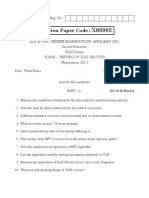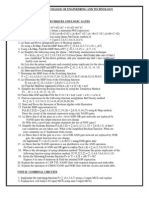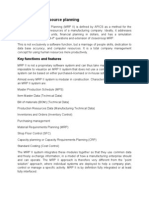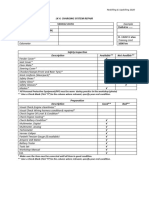Ap9212 Adsd
Ap9212 Adsd
Uploaded by
Kartheeswaran ArumugamCopyright:
Available Formats
Ap9212 Adsd
Ap9212 Adsd
Uploaded by
Kartheeswaran ArumugamOriginal Title
Copyright
Available Formats
Share this document
Did you find this document useful?
Is this content inappropriate?
Copyright:
Available Formats
Ap9212 Adsd
Ap9212 Adsd
Uploaded by
Kartheeswaran ArumugamCopyright:
Available Formats
SARDAR RAJA COLLEGE OF ENGINEERING, ALANGULAM DEPARTMENT OF ELECTRONICS AND COMMUNICATION M.
E (APPLIED ELECTROINCS) SUBJECT NAME: ADVANCED DIGITAL SYSTEM DESIGN SUBJECT CODE: AP9212 YEAR/SEM: 1/1
UNIT 1 PART A 1. What is the difference between flowchart and ASM chart? 2. Distinguish between mealy and moore models.
3.
What do you mean by sequential circuit? Explain with the help of the block diagram.
4. Comparison between combinational and sequential circuits. 5. Mention the two types of synchronous sequential machine with example. 6. Compare Algorithmic state machine and finite state machine. 7. Draw the block diagram of a synchronous clocked sequential circuit.
8.
Show that the characteristic equation for the complement output of a JK flip flop is Q1(t+1) =J1Q1 + KQ
9. What are rules applied for the state reduction?
10. A
sequential network has an input x and output y and z. yz represents a
2bit binary number equal to the number that have been received an inputs. The network resets when the total number of 1s received is 3. Find a moore state graph for the network.
11.What is the use if ASM charts?
UNIT 1 PART B
1.
Construct a ASM block that has 3 input variables (A, B, C), 4 outputs (w,x,y,z) and 2 exit paths. For this block, output Z is always 1, and w is 1 if A and B are both 1. If c=1 and A=0, y=1 and exit path 1 is taken. If C=0 or A=1, X=1 and exit path 2 is taken.
2. Design a counter that counts pulses an line w and displays the count in the sequence. 0,2,1,3,0,2. Use D flip flop in your circuit. 3. Design a count with the following repeated binary sequence: 0,1,2,3,4,5,6. Use JK flip flop. 4. A sequential circuit has are flip flop Q two input x and y, and one output S. It consists of a full adder circuit connected to a D flip flop. Derive the state table and state diagram of the sequential circuit. What do you this circuit resoresent? 5. Using S R flip flop, design a parallel counter which counts in the sequence 000, 111, 110, 001, 010, 000. 6. Develop a block diagram and an ASM chart for a digital circuit that multiples two binary numbers by the repeated addition method.
UNIT -2 PART A
1. Define Hazards. 2. What is critical race and non critical race? 3. Explain state reduction procedure to generate reduced flow table from a primitive flow table. 4. Differentiate static and Dynamic Hazard. 5. Define fundamental mode operation of asynchronous sequential circuit. 6. Prove that dynamic hazard do not happen in two level AND OR circuit. 7. What are the advantages and disadvantages of are hot method assignments? 8. What are the situations the synchrmous networks unsuitable? 9. Write the types of Hazards? 10.Briefly explain about transition table in ASC? 11.Write short notes an static Hazard? 12.Write short notes an dynamic Hazard? 13.Write short notes an essential Hazard? 14.What is lock out condition? How it is avoided.
UNIT -2 PART - B 1. Explain static, dynamic and essential Hazards in digital circuit. Give Hazard free realization for the following Boolean function f (A, B, C, D) = m (2, 8, 5, 7, 10, 14) 2. Design an asynchronous sequential circuit with two Inputs x and y and with one output Z. Whenever y is 1. Input x is transferred to Z. When y is 0, the output does not change for any change in x. 3. An Asynchranous sequential circuit is described by the following excitation and output unction Y = x1 x2 + (x1+x2) y Z=Y i. ii. iii. Draw the logic diagram of the circuit Derive the transition table and output map. Describe the behavior of the circuit
4. Explain the Design procedure using stage table reduction method. 5. Find a circuit that has no static hazard and implements the Boolean function. F (A, B, C, D) + (0, 2, 6, 7, 8, 12) 6. The Boolean functions for the inputs of an SR latch are S= R= Obtain the circuit diagram using a minimum number of NAND gates.
UNIT - 3
PART - A
1. When a path is said to be sensitized? Define a tree like circuit. 2. What is D algorithm? 3. What are the advantages of using Boolean difference method over bath sensitization method? 4. What is the need for DFT in testing? 5. Define Reconvergent fan out? 6. Explain IDD Q test 7. Explain D calculus 8. What is s a o and s a i? 9. What is path sensitization method. 10.What is Fault table method?
UNIT - 3 PART B
1. Find a minimal complete test set for detecting all distinguishable single faults in the irredundant circuit shown below by the fault table method. x1 a x2 b3 x c d e x+ 4 z
2. Construct a complete test set of the circuit shown below by sensitizing its four paths. x1 x3 x2
3. Explain in detail about Built in self test method of testing digital circuits. 4. Discuss about the path sensitization and D algorithm for test vector generation 5. Determine the test vector for the logic circuit Z = (BC) 1 + B1 A which has a reconvergent fan out problem. 6. Find the all the (Input and output) faults of the following expression using fault table F1 = ab + aie 7. Find a minimum set of set of test that win test all single stuck at o and stuck at fault in the following expression. F = (abc + def + ghi) For each test, specify which faults are tested for s - a - 0 and s - a 1
UNIT - 4 PART - A
1. Draw the basic ROM structure. 2. Comparison between PROM, PLA and PAL. 3. Draw the block diagram of PLA. 4. Draw the logic construction of 64 x 4 ROM. 5. Explain the method of implementing logic circuit in PLA. 6. Explain the method of implementing logic circuit in PAL. 7. Explain the method of implementing logic circuit in FPGA. 8. Difference between synchronous sequential circuit and asynchronous sequential circuit. 9. Compare combinational and sequential circuit.
UNIT - 4 PART - B
1. Draw and Explain X1 LINX 4000 series FPGA. 2. Implementation the following Boolean functions using PAL. W (A, B, C, D) = m (0, 2, 6, 7, 8, 9, 12, 13) X (A, B, C, D) = m (0, 2, 6, 7, 8, 9, 12, 13, 14) Y (A, B, C, D) = m (2, 3, 8, 9, 10, 12, 13,) Z (A, B, C, D) = m ( 1, 3, 4, 6, 9, 12, 14)
3. Design a BCD to excess 3 code convertors and implement using suitable PLA. 4. Realize the function gives using a PLA with 6 inputs, 4 outputs and 10 AND gates. F1 (A, B, C, D, E, F,) = m (0, 1, 7, 8, 9, 10, 11, 15, 19, 23, 27, 31, 32, 35, 39, 40, 41, 47, 63) F2 (A, B, C, D, E, F,) = m (8, 9, 10, 11, 12, 14, 21, 25, 27, 40, 41, 42, 43, 44, 46, 57, 59) 5. Draw a PLA circuit in implement the functions. F1 = A1B + AC1 + A1 BC1 F2 = (AB + AC + BC) 1 6. Draw and explain the architecture of xilinx FPGA. 7. Explain the architecture of PLA. 8. Implement the following functions in FPGA. F1 (A, B, C, D, E) = (0, 5, 7, 20, 23, 25, 31)
F2 (W, X, Y, Z) = (2, 4, 8, 11, 13, 15)
UNIT 5 PART A 1. What is the role of test bench in HDL language? 2. How do you declare two dimensional array in VADL? 3. List the VHDL operators with suitable examples. 4. Differentiate signals and variables in VHDL programming. 5. Develop a behavioral model of the two to one line multiplener.
6.
What is the value of E in the following HDL block, assuming that RA = 1? RA = RA-1; If (RA = 0) E = 1; else E = 0
7. Develop a structural model of the two to one line multiplexer. 8. Develop a behavior model of the half adder. 9. Develop a behavior model of the full adder. 10.Difference between mux and decoder. 11.Comparison between serial adder and parallel adder. 12.What are the advantages using package? 13.Write short notes an concurrent VHDL? 14.What are the different types of test bench in VHDL for simulating a module.
UNIT 5 PART B 1. Write a VHDL program for 8 bit counter using D flip flop. 2. Write a VHDL program for 4 bit ripple carry adder using structural description? (Use basic gates AND, OR, XOR . etc) and also write test bench program. 3. Explain the concurrent and sequential statements in VHDL programming each with syntax and example. 4. Write the VHDL code for the following specification: i. ii. A counter that has a count sequence 0, 1, 2, 3, 0, 1, 2, 3, 0, 1, 2,. 4 bit shift register with a control knob, K. if K = 1 then the register shifts data right and if K = 0 the register shifts the data left.
5. Write the HDL behavioral and structural descriptions of a Four bit register with parallel load and asynchronous clear. 6. Using a case statement, develop a behavioral model of one 8 - 4 - 2 - 1 to BCD code converter.
You might also like
- 00 - 01 BWMS OPERATION MANUAL - Rev PDFDocument79 pages00 - 01 BWMS OPERATION MANUAL - Rev PDFCelal Bozdogan100% (1)
- J-STD-001E Table of ContentsDocument6 pagesJ-STD-001E Table of ContentskhanjrkhanNo ratings yet
- VHDL Interview Question(s)Document8 pagesVHDL Interview Question(s)Sudheer AcharyaNo ratings yet
- TECH 158 - Digital Electronics (Winter 2020) Lab #2: Ripple Counters ObjectivesDocument1 pageTECH 158 - Digital Electronics (Winter 2020) Lab #2: Ripple Counters ObjectivesLoveWorldCanadaNo ratings yet
- Me2255 Electronics and Microprocessor Anna University Question BankDocument6 pagesMe2255 Electronics and Microprocessor Anna University Question BankMayakannan RNo ratings yet
- Ap7102 AdsdDocument5 pagesAp7102 AdsdshankarNo ratings yet
- EC8001 SyllabusDocument1 pageEC8001 SyllabusSarika AyyathuraiNo ratings yet
- Ec8392 Digital Electronics SyllabusDocument2 pagesEc8392 Digital Electronics SyllabusNandha KumarNo ratings yet
- WCN JNTUH Question PapersDocument1 pageWCN JNTUH Question PapersTelugu SatyanarayanaNo ratings yet
- Assignment 8 - 2023 - GateDocument10 pagesAssignment 8 - 2023 - GateS S KASHYAPNo ratings yet
- Software For Embedded SystemDocument39 pagesSoftware For Embedded Systemjani28cseNo ratings yet
- M.tech VLSI SEM II MID I ImportantQuestionsDocument13 pagesM.tech VLSI SEM II MID I ImportantQuestionsManoj ManuNo ratings yet
- EC482 Biomedical Engineering (Ktustudents - In)Document3 pagesEC482 Biomedical Engineering (Ktustudents - In)Sachin SukumaranNo ratings yet
- Testing and ValidationDocument648 pagesTesting and ValidationVishwajeet S BNo ratings yet
- EC3561-VLSI LAB Manual - R-2021 - 2023-2024 FinalDocument200 pagesEC3561-VLSI LAB Manual - R-2021 - 2023-2024 FinalsubishasuzaNo ratings yet
- Design of Testable Sequential CircuitsDocument44 pagesDesign of Testable Sequential CircuitsMahesh S GourNo ratings yet
- M.E Adsd Question PaperDocument2 pagesM.E Adsd Question PapershankarNo ratings yet
- Scilab Manual For Digital Signal Processing by MR Vijay P Sompur Electronics Engineering Visvesvraya Technological UniversityDocument51 pagesScilab Manual For Digital Signal Processing by MR Vijay P Sompur Electronics Engineering Visvesvraya Technological Universitysuvarnalatha devarakonda100% (1)
- A Textbook of Electronic Circuits - R. S. SedhaDocument186 pagesA Textbook of Electronic Circuits - R. S. Sedhaarun0% (1)
- VLSI Design and VerificationDocument11 pagesVLSI Design and VerificationopenhousehereNo ratings yet
- AP7101-Advanced Digital Signal ProcessingDocument8 pagesAP7101-Advanced Digital Signal ProcessingDhamodharan Srinivasan50% (2)
- Lecture 6 Gajski Kuhn Y ChartDocument18 pagesLecture 6 Gajski Kuhn Y ChartShiraz HusainNo ratings yet
- Ad Hoc and Wireless Sensor Networks - Ec8702: Session byDocument28 pagesAd Hoc and Wireless Sensor Networks - Ec8702: Session byRaja MadhuvanthiNo ratings yet
- Question Bank DFTS: BE 4/4 ECE II Semester Elective II Unit IDocument4 pagesQuestion Bank DFTS: BE 4/4 ECE II Semester Elective II Unit IAbdul Hadi Abdul RawoofNo ratings yet
- Electronic Devices Model Question PapersDocument2 pagesElectronic Devices Model Question Papersk_kunarajNo ratings yet
- Question Paper Code:: Reg. No.Document2 pagesQuestion Paper Code:: Reg. No.Karthiga MuruganNo ratings yet
- Explain Small Signal AC Characteristics of MOSFET With Its Design EquationsDocument11 pagesExplain Small Signal AC Characteristics of MOSFET With Its Design EquationsradhikasontakayNo ratings yet
- VlSI Design OU Question PaperDocument1 pageVlSI Design OU Question PapershivagurramNo ratings yet
- 1 - Low Power IC Design - SyllabusDocument3 pages1 - Low Power IC Design - Syllabusraveen kumarNo ratings yet
- Microcontroller Lab ManualDocument38 pagesMicrocontroller Lab ManualAkash Kumar58% (12)
- Testing Int 1 AugDocument2 pagesTesting Int 1 AugRamJiDRNo ratings yet
- Vlsi MCQDocument1 pageVlsi MCQhiren467_ecNo ratings yet
- An Economical Class of Digital Filters For Decimation and Interpolation-FoLDocument8 pagesAn Economical Class of Digital Filters For Decimation and Interpolation-FoLKishlay KumarNo ratings yet
- Digital Lab VIVA QuestionsDocument4 pagesDigital Lab VIVA QuestionsAnirudhan RaviNo ratings yet
- 9A04706 Digital Design Through Verilog HDL PDFDocument4 pages9A04706 Digital Design Through Verilog HDL PDFTayyabunnissa BegumNo ratings yet
- VLSI Important QuestionsDocument19 pagesVLSI Important Questionsratnams100% (1)
- 21EC654 Model Question Papers-1Document3 pages21EC654 Model Question Papers-1Srikanth Raja100% (1)
- Answer All Questions PART A - (5 2 10)Document3 pagesAnswer All Questions PART A - (5 2 10)Anonymous NV7nnJDe100% (1)
- AP4111 Manual Electronic System DesignDocument87 pagesAP4111 Manual Electronic System Designhmpudur1968No ratings yet
- Question PaperDocument6 pagesQuestion PaperLavanya Vaishnavi D.A.No ratings yet
- Assignments - NOC - MATLAB Programming For Numerical ComputationDocument9 pagesAssignments - NOC - MATLAB Programming For Numerical ComputationPraghashrajaNo ratings yet
- Model Exam Ocn 3Document2 pagesModel Exam Ocn 3Prabu KumarNo ratings yet
- VLSI-PPT-Module-3-Delays and SubsystemsDocument10 pagesVLSI-PPT-Module-3-Delays and SubsystemsChandra Shekar MedarNo ratings yet
- Embedded Syatem Question Paper.Document1 pageEmbedded Syatem Question Paper.Saurabh SinghNo ratings yet
- Vlsi Lab Question SetDocument4 pagesVlsi Lab Question SetM.S.Anandhi100% (1)
- Analog & Digital VLSI Design Practice QuestionsDocument24 pagesAnalog & Digital VLSI Design Practice QuestionsAbhinav MishraNo ratings yet
- PDC Model Question PaperDocument2 pagesPDC Model Question PaperMuthe MuraliNo ratings yet
- COA Lab Exam Question PaperDocument3 pagesCOA Lab Exam Question PaperwahidNo ratings yet
- Ece-Vii-dsp Algorithms & Architecture (10ec751) - AssignmentDocument9 pagesEce-Vii-dsp Algorithms & Architecture (10ec751) - AssignmentMuhammadMansoorGohar100% (1)
- Me Vlsi Lab ManualDocument66 pagesMe Vlsi Lab Manualaarthi.lj5371No ratings yet
- Question Paper Code:: Reg. No.Document3 pagesQuestion Paper Code:: Reg. No.Karthiga MuruganNo ratings yet
- Vtu Old Question Papers - Best PDFDocument1 pageVtu Old Question Papers - Best PDFpoojabadigerNo ratings yet
- Ec3352 Set3Document3 pagesEc3352 Set3menakadevieceNo ratings yet
- Question Bank - ADSD ET7101Document7 pagesQuestion Bank - ADSD ET7101karthikamageshNo ratings yet
- Digital Logic CircuitsDocument7 pagesDigital Logic CircuitsMATHANKUMAR.SNo ratings yet
- ADE PreparatoryQBDocument3 pagesADE PreparatoryQBShivaayNo ratings yet
- Question Bank For DLCDocument8 pagesQuestion Bank For DLCAvina AshNo ratings yet
- 21cs33 Super Important - 21SCHEMEDocument3 pages21cs33 Super Important - 21SCHEMEGagan V hallurNo ratings yet
- Digital Electronics QBDocument7 pagesDigital Electronics QBvinaytmkNo ratings yet
- Subject Code/ Title: Ee6301 Digital Logic Circuits Year/ Sem/Branch: Ii/ Iii/ EeeDocument16 pagesSubject Code/ Title: Ee6301 Digital Logic Circuits Year/ Sem/Branch: Ii/ Iii/ EeePavithra ManiNo ratings yet
- Digital 16 Marks.Document4 pagesDigital 16 Marks.Saranya PrabhuNo ratings yet
- MRP2Document2 pagesMRP2ravi51628513No ratings yet
- Solution of Exercise 1: FY8201 / TFY8 Nanoparticle and Polymer Physics IDocument3 pagesSolution of Exercise 1: FY8201 / TFY8 Nanoparticle and Polymer Physics ISerpil YilmazNo ratings yet
- Helium Leak Detection - Manufactering ColboxDocument9 pagesHelium Leak Detection - Manufactering ColboxhoseinNo ratings yet
- The Theory of Ostwald Rippening (Voorhess)Document22 pagesThe Theory of Ostwald Rippening (Voorhess)serchNo ratings yet
- Hyundai Accent 2005 UKDocument12 pagesHyundai Accent 2005 UKMochammad SyukronNo ratings yet
- ACS 1000 Medium Voltage Drives: 315 - 5000 KW 400 - 6200 HPDocument112 pagesACS 1000 Medium Voltage Drives: 315 - 5000 KW 400 - 6200 HPcldanghel4648No ratings yet
- Oil Well Flowline Mto by HENRY TOGA PAHALA SIANTURIDocument7 pagesOil Well Flowline Mto by HENRY TOGA PAHALA SIANTURIPahala2016 toga100% (2)
- T40 RattlerDocument3 pagesT40 RattlerDeo MananganNo ratings yet
- AmsoilBreak-In Oil (SAE 30) g2881Document2 pagesAmsoilBreak-In Oil (SAE 30) g2881amsoilromaniaNo ratings yet
- Pfeiffer-sem2023-p15-Mill Shell LiningsDocument32 pagesPfeiffer-sem2023-p15-Mill Shell Liningsmoathqatawneh444No ratings yet
- Java Programming Part IDocument120 pagesJava Programming Part Iparesh.bapnaNo ratings yet
- Vellore To Get A New Bus TerminusDocument6 pagesVellore To Get A New Bus TerminusBehemothNo ratings yet
- Binks AX260L Air Motor BreakdownDocument11 pagesBinks AX260L Air Motor BreakdownAryo KamandanuNo ratings yet
- Chdeb AmbaraDocument16 pagesChdeb AmbaravsmkreddysNo ratings yet
- 19 Fookes Stabilization and Control of Local Rockfalls EtcDocument20 pages19 Fookes Stabilization and Control of Local Rockfalls EtcIbnuyusoff77No ratings yet
- HP S3100V2 MIB CompanionDocument401 pagesHP S3100V2 MIB CompanionWagner VictoriaNo ratings yet
- CMIT-796-PIP-15.69-00-0008 - 0 3D Model Review ProcedureDocument10 pagesCMIT-796-PIP-15.69-00-0008 - 0 3D Model Review ProcedurenadaNo ratings yet
- Class 7Document24 pagesClass 7karthikNo ratings yet
- Repairs of D-Wall Exposed ReinforcementDocument7 pagesRepairs of D-Wall Exposed Reinforcement陈勇No ratings yet
- Noise EmissionDocument41 pagesNoise Emissionvesna pavelkicNo ratings yet
- Dong I Marine TransmissionDocument32 pagesDong I Marine TransmissionRita Morice GómezNo ratings yet
- Daihatsu : LK 4. Charging System Repair Vehicle DataDocument4 pagesDaihatsu : LK 4. Charging System Repair Vehicle DataNengah Saputra WijayaNo ratings yet
- Analyzing Oracle TraceDocument13 pagesAnalyzing Oracle TraceChen XuNo ratings yet
- Steel Design CombineDocument4 pagesSteel Design CombineLenielle AmatosaNo ratings yet
- Aashto T104-22Document12 pagesAashto T104-22jaheshfarhad100% (1)
- Vermiculate Artefacts in Image Analysis of Granular MaterialsDocument14 pagesVermiculate Artefacts in Image Analysis of Granular Materialsjoake spasNo ratings yet
- Bank LoanDocument441 pagesBank LoanDhansiri HouseNo ratings yet
- Jet Fans: Singapore T: +65-65660371 F: +65-65626736 Asia Distribution - Please Contact UsDocument2 pagesJet Fans: Singapore T: +65-65660371 F: +65-65626736 Asia Distribution - Please Contact Uspo truongNo ratings yet




